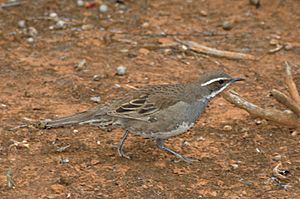Cinclosomatidae facts for kids
Quick facts for kids Cinclosomatidae |
|
|---|---|
 |
|
| Spotted quail-thrush (Cinclosoma punctatum) | |
| Scientific classification |
|
| Kingdom: | Animalia |
| Phylum: | Chordata |
| Class: | Aves |
| Order: | Passeriformes |
| Superfamily: | Corvoidea |
| Family: | Cinclosomatidae Mathews, 1921 |
| Genera | |
|
See list below |
|
The Cinclosomatidae are a family of passerine birds. These are birds that can perch on branches. They live in Australia and New Guinea. This family includes birds like the quail-thrushes and the jewel-babblers. Scientists have changed their minds over time about which birds belong in this family.
Contents
About the Cinclosomatidae Family
These birds are medium-sized songbirds. They are usually between 17 and 28 centimeters long. They have strong legs and strong bills. Male and female birds often have different markings on their feathers.
Quail-thrushes
Quail-thrushes are mostly brown on their backs. This helps them blend in with the ground. They have bolder black and white markings on their undersides.
Jewel-babblers
Jewel-babblers often have a lot of blue color in their feathers. Most birds in this family have loud and special songs.
Where These Birds Live
Jewel-babblers live on the island of New Guinea. They also live on nearby islands like Yapen, Batanta, Misool, and Salawati. You can find them in forests. Different types of jewel-babblers live at different heights in the mountains.
The painted quail-thrush also lives in the forests of New Guinea. Other quail-thrushes live only in Australia. They prefer drier places like open forests, scrublands, and rocky areas.
Scientists do not think that any of these species are endangered. However, one type of the spotted quail-thrush is in great danger. It might even be extinct.
How They Behave
Jewel-babblers and quail-thrushes spend most of their time on the ground. They do not fly very well. If something scares them, they usually squat down or run away.
They look for food on the ground. They mainly eat insects and other small creatures without backbones. Quail-thrushes that live in the desert also eat some seeds.
These birds build a nest shaped like a cup. They place their nests among bushes or right on the ground. Female birds usually lay two or three eggs.
Species List
- Genus Cinclosoma – These are the quail-thrushes
- Painted quail-thrush, Cinclosoma ajax
- Spotted quail-thrush, Cinclosoma punctatum
- Chestnut quail-thrush, Cinclosoma castanotum
- Copperback quail-thrush, Cinclosoma clarum
- Chestnut-breasted quail-thrush, Cinclosoma castaneothorax
- Western quail-thrush, Cinclosoma marginatum
- Nullarbor quail-thrush, Cinclosoma alisteri
- Cinnamon quail-thrush, Cinclosoma cinnamomeum
- Genus Ptilorrhoa – These are the jewel-babblers
- Spotted jewel-babbler, Ptilorrhoa leucosticta
- Blue jewel-babbler, Ptilorrhoa caerulescens
- Brown-headed jewel-babbler, Ptilorrhoa (caerulescens) geisleroroum
- Chestnut-backed jewel-babbler, Ptilorrhoa castanonota
See also
 In Spanish: Cinclosomátidos para niños
In Spanish: Cinclosomátidos para niños


